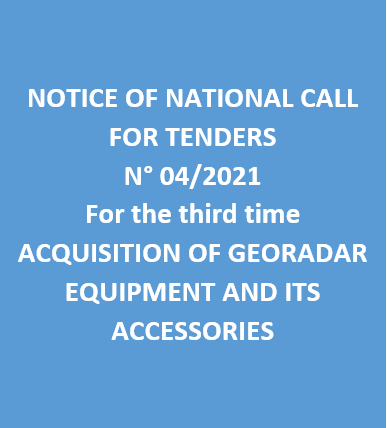| Annual program and technical progress report |
-

Activity Report 2023
-

Technical Program 2024
|
| Geocatalogue |

|
| Invitation to
tender |
-

REALIZATION OF THE TRAINING PLAN FOR THE YEAR 2022
-

ACQUISITION OF TWO SERVICE CARS
-

ACQUISITION OF GEORADAR EQUIPMENT AND ITS ACCESSORIES
|
|
Invest in Tunisia |

|
|
|
|
|
::
Documentation and Editions
>>
Research library
|
| |
|
[
Search by author
]
[
Search keyword
]
[
Search by index
]
[
Search by category
]
|
title of the reference :
|
Indices de distension pendant le Quaternaire récent en Tunisie
|
|
Publication Date:
|
1984
|
|
Author :
|
Martinez Claude, Paskoff Roland
|
|
Catalogue type :
|
Livre
|
|
Catalogue reference :
|
Vol.XIV, N°2 (FRA) Cah. ORSTOM : Pédol. Vol.XIV, N°2 Indices de distension pendant le Quaternaire récent en Tunisie leur signification dans un régime de compression généralisée. Pendant et après le Tyrrhénien,la côte de Tunisie est soumise à un régime de compression généralisée proche de N-S.Dans la région de Bizerte,la déformation présente des plis et des failles inverses tandis que,dans les environs de Monastir,elle est décrochante-distensive. biliogr. néotectonique ; compression ; faille décrochement ; trangression ; Quaternaire ; Tyrrhénien ; distention ; Formation Chebba ; Formation Réjiche ; Formation Aïn Oktor ; Formation Cap Blanc ; Tunisie ; Tunisie Nord Orientale ; Tunisie Orientale Sahel ; Bizerte ; Monastir ; Ras el Koran ; Sounine ; Raf Raf ; Skanès ; Khniss ; Sahline ; Kerkennah Martinez Claude Paskoff Roland Géomorphologie, Pédologie
|
|
Indexation decimale :
|
Géomorphologie, Pédologie
|
|
Keywords :
|
néotectonique ; compression ; faille décrochement ; trangression ; Quaternaire ; Tyrrhénien ; distention ; Formation Chebba ; Formation Réjiche ; Formation Aïn Oktor ; Formation Cap Blanc ; Tunisie ; Tunisie Nord Orientale ; Tunisie Orientale Sahel ; Bizerte ; Monastir ; Ras el Koran ; Sounine ; Raf Raf ; Skanès ; Khniss ; Sahline ; Kerkennah
|
|
Summary :
|
Pendant et après le Tyrrhénien,la côte de Tunisie est soumise à un régime de compression généralisée proche de N-S.Dans la région de Bizerte,la déformation présente des plis et des failles inverses tandis que,dans les environs de Monastir,elle est décrochante-distensive.
|
|
Exemplaries :
|
TU862B, TU862A
|
|
|
|
|
|
|
|



